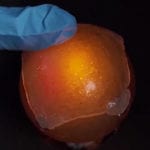 Weird Stuff
Weird Stuff  Weird Stuff
Weird Stuff  Mysteries
Mysteries 10 Tragic Disappearances and Deaths in Joshua Tree National Park
 History
History 10 Ways Childhood Really Sucked in the Old West
 Music
Music 10 Name Origins of Famous Bands from the 1990s
 Religion
Religion 10 Biggest Turnarounds by the Catholic Church
 Weird Stuff
Weird Stuff 10 Unbelievable Times Laws Had Unintended Consequences
 Humans
Humans Ten Historic Women Who Deserve Way More Credit Than They Got
 Movies and TV
Movies and TV 10 Films That Spawned Major Lawsuits
 History
History Ten Times Towns Were Wiped Off the Face of the Earth
 Creepy
Creepy 10 of the Most Disturbingly Haunted Public Houses in the UK
 Weird Stuff
Weird Stuff 10 Niche Subcultures That Are More Popular Than You Might Think
 Mysteries
Mysteries 10 Tragic Disappearances and Deaths in Joshua Tree National Park
 History
History 10 Ways Childhood Really Sucked in the Old West
Who's Behind Listverse?

Jamie Frater
Head Editor
Jamie founded Listverse due to an insatiable desire to share fascinating, obscure, and bizarre facts. He has been a guest speaker on numerous national radio and television stations and is a five time published author.
More About Us Music
Music 10 Name Origins of Famous Bands from the 1990s
 Religion
Religion 10 Biggest Turnarounds by the Catholic Church
 Weird Stuff
Weird Stuff 10 Unbelievable Times Laws Had Unintended Consequences
 Humans
Humans Ten Historic Women Who Deserve Way More Credit Than They Got
 Movies and TV
Movies and TV 10 Films That Spawned Major Lawsuits
 History
History Ten Times Towns Were Wiped Off the Face of the Earth
 Creepy
Creepy 10 of the Most Disturbingly Haunted Public Houses in the UK
10 Reasons Why Our Universe Is A Virtual Reality
Physical realism is the view that the physical world we see is real and exists by itself, alone. Most people think this is self-evident, but physical realism has been struggling with the facts of physics for some time now. The paradoxes that baffled physics last century still baffle it today, and its great hopes of string theory and supersymmetry aren’t leading anywhere.
In contrast, quantum theory works, but quantum waves that entangle, superpose, then collapse to a point are physically impossible—they must be “imaginary.” So for the first time in history, a theory of what doesn’t exist is successfully predicting what does—but how can the unreal predict the real?
Quantum realism is the opposite view—that the quantum world is real and is creating the physical world as a virtual reality. Quantum mechanics thus predicts physical mechanics because it causes them. Physics saying that quantum states don’t exist is like the Wizard of Oz telling Dorothy, “Pay no attention to the man behind the curtain.”
Quantum realism isn’t The Matrix, where the other world making ours was also physical. Nor is it a brain-in-a-vat idea, as this virtuality was in play long before humans came along. Nor is it that a phantom other world modifies ours—our physical world is the phantom. In physical realism, the quantum world is impossible, but in quantum realism the physical world is impossible—unless it is a virtual reality—as these examples demonstrate.
10Our Universe Began
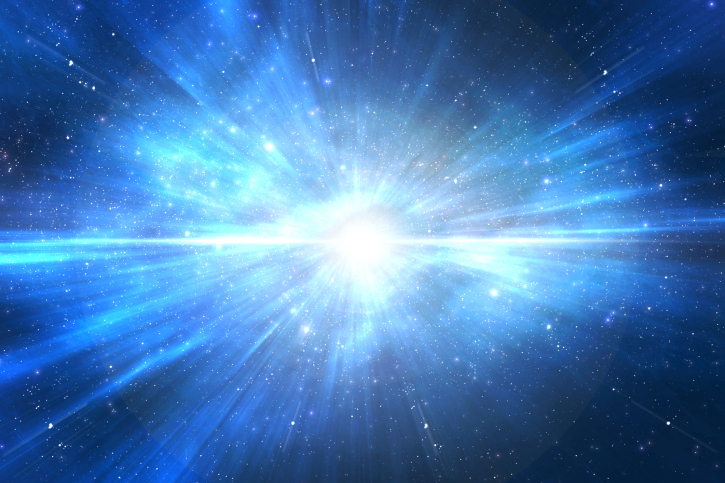 Physical Realism: Everyone has heard of the Big Bang, but if the physical universe is all there is, how did it begin? A complete universe shouldn’t change overall, as there is nowhere else for it to go to or come from, and nothing else that can alter it. Yet in 1929, the astronomer Edwin Hubble found that all the galaxies were expanding away from us, implying a Big Bang that happened at a point in space-time over 14 billion years ago. The discovery of cosmic background radiation all around us (seen as static on our TV screens) confirmed that not only did our entire universe begin at that point, but its space and time began then as well.
Physical Realism: Everyone has heard of the Big Bang, but if the physical universe is all there is, how did it begin? A complete universe shouldn’t change overall, as there is nowhere else for it to go to or come from, and nothing else that can alter it. Yet in 1929, the astronomer Edwin Hubble found that all the galaxies were expanding away from us, implying a Big Bang that happened at a point in space-time over 14 billion years ago. The discovery of cosmic background radiation all around us (seen as static on our TV screens) confirmed that not only did our entire universe begin at that point, but its space and time began then as well.
Now, a universe that began either existed before its creation to make itself, which is impossible, or it was made by something else. It is impossible that a complete universe began by itself, from nothing. Yet oddly enough, this is what most physicists today believe. They suggest the first event was a quantum fluctuation of the vacuum (in quantum mechanics, pairs of particles and antiparticles are known to hop in and out of existence). But if matter just popped out of space, what did space pop out of? How can a quantum fluctuation in space create space? How can time itself begin?
Quantum Realism: Every virtual reality boots up with a first event that also begins its space and time. In this view, the Big Bang was when our physical universe booted up, including its space-time operating system. Quantum realism suggests that the big bang was really the big rip.
9Our Universe Has A Maximum Speed
 Physical Realism: Einstein deduced that nothing goes faster than light in a vacuum from how our world behaves, and this has subsequently been considered a universal constant, but it isn’t clear why this is the case. Currently: “the speed of light is a constant because it just is, and because light is not made of anything simpler.”
Physical Realism: Einstein deduced that nothing goes faster than light in a vacuum from how our world behaves, and this has subsequently been considered a universal constant, but it isn’t clear why this is the case. Currently: “the speed of light is a constant because it just is, and because light is not made of anything simpler.”
To answer “Why can’t things go faster and faster?” with “Because they can’t” is hardly satisfactory. Light slows down in water or glass, and when it moves in water we say the medium is water, and when it moves in glass we say the medium is glass, but when it moves in empty space we fall silent. How can a wave vibrate nothing? There is no physical basis for light to move in empty space at all, let alone define the fastest speed possible.
Quantum Realism: If the physical world is a virtual reality, it is the product of information processing. Information is defined as a choice from a finite set, so the processing changing it must also be finite, and indeed our world does refresh at a finite rate. A supercomputer processor refreshes 10 quadrillion times a second, and our universe refreshes a trillion, trillion times faster than that, but the principle is the same. As a screen image has pixels and a refresh rate, so our world has Planck Length and Planck Time.
In this scenario, the speed of light is the fastest speed because the network can’t transmit anything faster than one pixel per cycle—i.e., Planck Length divided by Planck Time, or about 300,000 kilometers per second. The speed of light should really have been called the speed of space.
8Our Time Is Malleable
Physical Realism: In Einstein’s twin paradox, one twin traveling in a rocket at nearly the speed of light returns a year later to find his twin brother an old man of 80. Neither twin knew their time ran differently and neither lost a heartbeat, but one’s life is nearly over and the other’s is just starting. This seems impossible in an objective reality, but time really does slow down for particles in accelerators. In the 1970s, scientists flew atomic clocks on aircraft around the world to prove they ticked slower than synchronized ones on the ground. But how can time, the arbiter of all change, itself be subject to change?
Quantum Realism: A virtual reality would be subject to virtual time, where each processing cycle is one “tick.” Every gamer knows that when the computer is busy the screen lags—game time slows down under load. Likewise, time in our world slows down with speed or near massive bodies, suggesting that it is virtual. So the rocket twin only aged a year because that was all the processing cycles the system busy moving him could spare. What changed was his virtual time.
7Our Space Curves
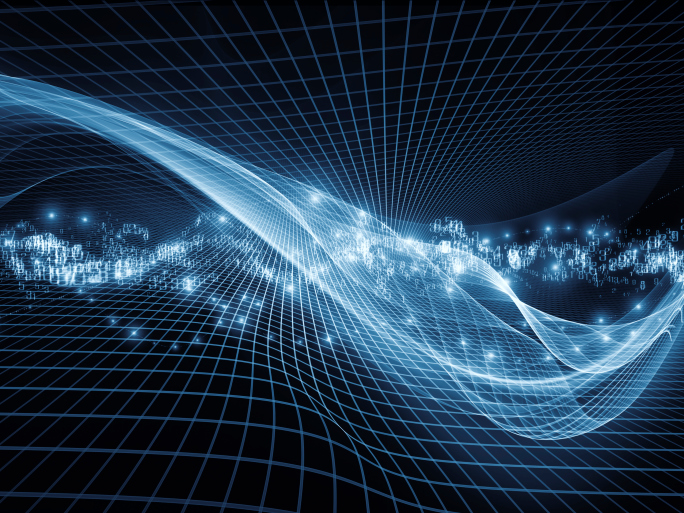 Physical Realism: According to Einstein’s theory of relativity, the Sun keeps the Earth in orbit by curving space around it, but how can space itself curve? Space by definition is that in which movement occurs, so for space to curve it has to exist in another space, which is an infinite regression. If matter exists in a space of nothing, for that nothing to move (or curve) is impossible.
Physical Realism: According to Einstein’s theory of relativity, the Sun keeps the Earth in orbit by curving space around it, but how can space itself curve? Space by definition is that in which movement occurs, so for space to curve it has to exist in another space, which is an infinite regression. If matter exists in a space of nothing, for that nothing to move (or curve) is impossible.
Quantum Realism: An “idle” computer isn’t really idle but busy running a null program, and our space could be the same. In the Casimir effect, the vacuum of space exerts a pressure on two flat plates close together. Current physics says that virtual particles pop out of nowhere to cause this, but in quantum realism empty space is full of processing that would have the same effect. And space as a processing network can present a three-dimensional surface capable of curving.
6Randomness Happens
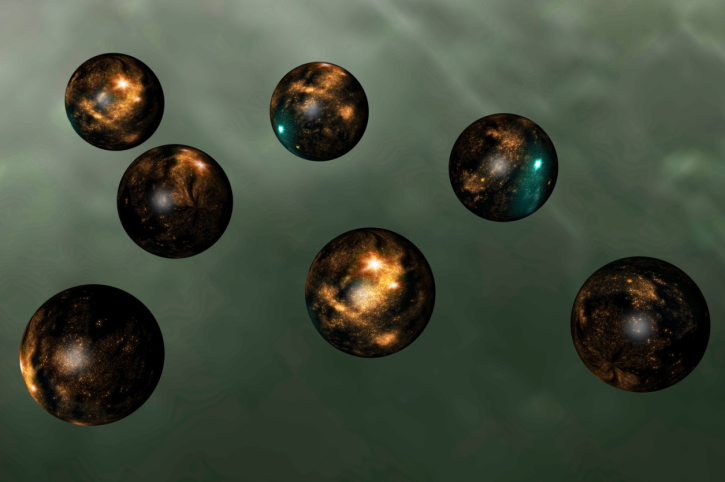 Physical Realism: In quantum theory, quantum collapse is random, so a radioactive atom can emit a photon whenever it wants to. A random event is one that no prior physical story explains. Quantum theory also holds that a physical event requires a random “collapse of the wave function,” so every physical event has a random element!
Physical Realism: In quantum theory, quantum collapse is random, so a radioactive atom can emit a photon whenever it wants to. A random event is one that no prior physical story explains. Quantum theory also holds that a physical event requires a random “collapse of the wave function,” so every physical event has a random element!
To meet this threat to the primacy of physical causation, in 1957 Hugh Everett proposed the many-worlds theory, the untestable idea that every quantum choice spawns a new universe, so every option actually occurs somewhere in a new “multiverse.” For example, if you chose toast for breakfast, nature makes another universe where you had peaches and cream. It was initially seen as ridiculous, which it is, but physicists today prefer this physics fairytale over other options because it dispels the nightmare of randomness.
Yet if quantum choices create new universes, it isn’t hard to see that “universes would be piling up at rates that transcend all concepts of infinitude.” The many-worlds fantasy doesn’t just offend Occam’s razor, it outrages it. Actually, the multiverse is just a reincarnation of the old perfectly predictable clockwork universe, which quantum theory disposed of last century. False theories don’t die, they just become zombie theories.
Quantum Realism: The processor in an online game can generate a value random to it, and our world could be the same. So quantum events are random to us because they involve client-server acts we have no access to. Quantum randomness seems pointless, but it plays the same role in the evolution of matter as genetic randomness does in biological evolution.
5Antimatter Occurs
Physical Realism: Antimatter refers to subatomic particles corresponding to the electrons, protons, and neutrons of regular matter, but with the opposite electric charge and other properties. In our universe, negative electrons orbit positive atomic nuclei. In an anti-matter universe, positive electrons would orbit negative nuclei, but it would look the same to its inhabitants as the laws of physics would be the same. Matter and antimatter annihilate each other on contact.
Paul Dirac’s equations predicted antimatter before it was found, but it was never clear why something that annihilates matter is even possible. The Feynman diagram of an electron meeting an anti-electron shows the latter entering the collision going back in time! As so often in physics today, the equation works but its implications make no sense. Matter doesn’t need an inverse, and time reversal undermines the causal foundations of physics. Antimatter is one of the most baffling findings of modern physics.
Quantum Realism: If matter is the result of processing and processing sets a sequence of values, it follows that those values can be set in reverse—processing implies anti-processing. In this light, antimatter is the inevitable by-product of matter created by processing. If time is the completion of forward processing cycles for matter, for antimatter it is the completion of backward cycles, so it logically runs our time in reverse. Matter has an inverse because the processing that creates it is reversible, and anti-time occurs for the same reason. Only a virtual time can have an inverse.
4The Two Slit Experiment
Physical Realism: Over 200 years ago, Thomas Young did an experiment that still baffles physicists today—he shone light through two parallel slits to get an interference pattern on a screen. Only waves do this, so a light particle (photon) must be actually be a wave. But the light also hits the screen at a point, which would only happen if a photon is a particle.
To find out more, physicists sent one photon at a time through Young’s slits. One photon gave the expected particle dot, but soon the dots built up into an interference pattern whose most likely impact point was behind the slit barrier! The effect is independent of time—so one photon going through the slits each year gives the same pattern. Each photon can’t know where the last one hit, so how does the pattern emerge? Detectors placed in either or both slits, to see where the photon goes, just fire half the time—a photon always goes by one slit or the other, never through both. In nature’s conspiracy of silence, a physical photon is a particle when we look but a wave when we don’t.
Current physics calls this the mystery of wave-particle duality, a “deeply weird” fact explainable only by esoteric equations of non-existent waves. Yet we all know that point particles can’t spread like waves and spreading waves can’t be point particles.
Quantum Realism: Quantum theory explains Young’s experiment with fictional waves that go through both slits, interfere, then collapse to a point at the screen. It works, but waves that don’t exist can’t explain what does. In quantum realism, a photon program can spread instances on the network like a wave, then restart at a point when a node overloads and reboots, like a particle. That what we call physical reality is that set of reboots explains both quantum waves and quantum collapse.
3Dark Energy And Dark Matter
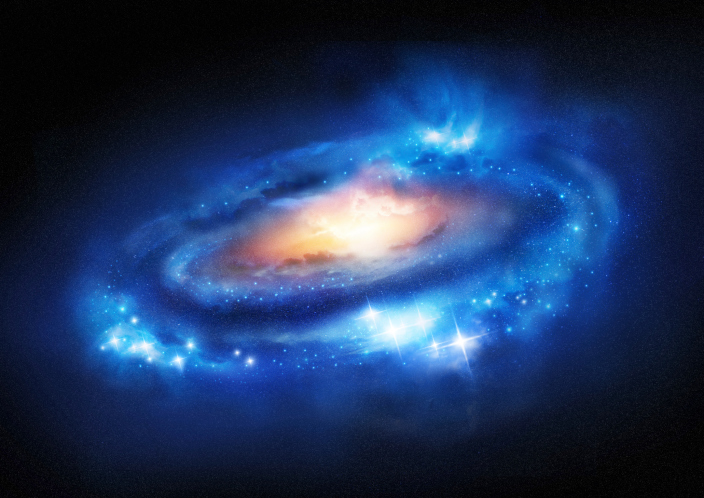 Physical Realism: Current physics describes the matter we see, but the universe also has five times as much of something called dark matter. It can be detected as a halo around the black hole at the center of our galaxy that binds its stars together more tightly than their gravity allows. It isn’t the matter we see as no light can detect it, it isn’t anti-matter as it has no gamma ray signature, and it isn’t a black hole as there is no gravitational lensing—but without it, the stars of our galaxy would fly apart in chaos.
Physical Realism: Current physics describes the matter we see, but the universe also has five times as much of something called dark matter. It can be detected as a halo around the black hole at the center of our galaxy that binds its stars together more tightly than their gravity allows. It isn’t the matter we see as no light can detect it, it isn’t anti-matter as it has no gamma ray signature, and it isn’t a black hole as there is no gravitational lensing—but without it, the stars of our galaxy would fly apart in chaos.
No known particles explain dark matter—hypothetical particles known as Weakly Interacting Massive Particles (WIMPs) have been proposed, but none have been found, despite talk of super-WIMPs. In addition, 70 percent of the universe is dark energy, and physics can’t explain that either. Dark energy is a sort of negative gravity, a weak effect spread through space that pushes things apart, thereby increasing the universe’s expansion. It hasn’t changed much over time, but something floating in an expanding space should gradually weaken. If it were a property of space then it should increase as space expands. Currently, no one has any idea what it is.
Quantum Realism: If empty space is null processing then it is not nothing, and if it is expanding then new space is being added all the time. New processing points, by definition, receive input but output nothing in their first cycle. So they absorb but don’t emit, exactly like the negative effect we call dark energy. If new space adds at a steady rate, the effect won’t change much over time, so dark energy is caused by the ongoing creation of space. The model also attributes dark matter to light in orbit around a black hole. It is a halo because light too close to the black hole is pulled into it and light too far away from it can escape the orbit. Quantum realism expects that no particles will ever be found to explain dark energy and dark matter.
2Electrons Tunnel
Physical Realism: In our world, an electron can suddenly pop up outside a Gaussian field it can’t penetrate, which is like a coin in a perfectly sealed glass bottle suddenly appearing outside it. In a purely physical world this isn’t possible, but in our world it is.
Quantum Realism: Quantum theory requires an electron to occasionally do the above because a quantum wave can spread regardless of physical barriers, and an electron can randomly collapse to any point in it. Each collapse is an image frame in the movie we call physical reality, except that the next frame isn’t fixed, but randomly based on probabilities. So an electron “tunneling” through an impenetrable field is like a movie that “cuts” from a view of an actor inside a house to outside.
That might sound odd, but teleporting from one state to another is how all quantum matter moves. We see a physical world that exists independent of our observation, but quantum theory’s observer effect implies it almost works like a game view, where if you look left a left view is created and if you look right a right view is shown. In Bohm’s Theory, a ghostly quantum wave guides the electron, but in this theory the electron is that ghostly wave. Quantum realism solves the quantum paradox by making the quantum world real and the physical world its product.
1Quantum Entanglement
Physical Realism: If a cesium atom releases two photons in opposite directions, quantum theory “entangles” them, so that if one is spinning upward, the other will spin downward. But if one is randomly spinning up, how does the other instantly know to spin down, at any distance? To Einstein, the discovery that measuring one photon’s spin instantly defines the spin of another anywhere in the universe was “spooky action at a distance.” The test of this was one of the most careful experiments ever done, as befits the ultimate test of our reality, and quantum theory was right yet again. Observing one entangled photon caused the other to have the opposite spin—even when it was too far away for a signal traveling at the speed of light to connect them. Nature could conserve spin by making one photon up and the other down from at the start, but that is apparently too much trouble. So it lets either spin either way, randomly, then when we measure one to be one way, it instantly makes the other the opposite, even though that is physically impossible.
Quantum Realism: In this view, two photons entangle when their programs merge to jointly run two points. If one program is spin-up and the other spin-down, their merger runs both pixels wherever they are. A physical event at either pixel restarts either program randomly, leaving the remaining opposite spin code to run the other pixel. This code re-allocation ignores distance, as a processor doesn’t have to “go to” a pixel to change it, even for a screen as big as our universe.
The standard model of physics involves 61 fundamental particles with data-fitted mass and charge parameters. If it were a machine, one would have to hand-set two dozen knobs just right for it to light up. It also needs five invisible fields to spawn 14 virtual particles with 16 different “charges” to work. You might expect completeness from all this, but the standard model can’t explain gravity, proton stability, anti-matter, quark charges, neutrino mass or spin, inflation, family generations, or quantum randomness—all critical issues. No particles account for the dark energy and dark matter that comprises most of the universe—and no particles ever will.
Quantum realism reinterprets the equations of quantum theory in terms of one network and one program. Its premise, that the physical world is a processing output, doesn’t make it a fake, as there is still a real world out there—it just isn’t the one we see. Reverse engineering the physical world suggests that matter evolved from light, as a standing quantum wave, so quantum realism predicts that light alone in a vacuum can collide to create matter. In contrast, the standard model says that photons can’t collide, so a definitive test of the virtual reality conjecture is possible. When light alone collides in a vacuum to create matter, the particle model will be replaced by one based on information processing. See this FAQ for common questions, go here for more details, or listen to this Chronicle of Higher Education podcast: Imagining Our World As A Virtual Reality.
Brian Whitworth, BA, BSc, MA, MPhil is a senior lecturer in computing at Massey University, Auckland, New Zealand. In his work on quantum realism, the impossible world of quantum theory is real and the physical world we see is virtual.






